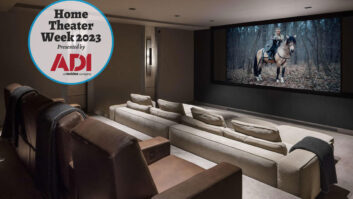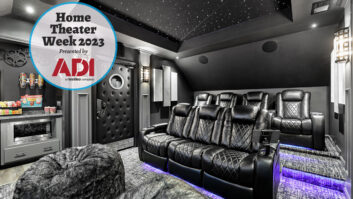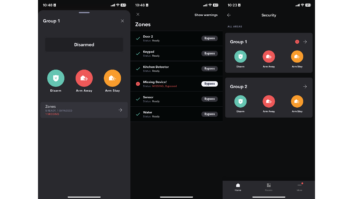Confusion and frustration brought on by the introduction of new gadgets, technologies and lifestyles can be downright overwhelming A/V installation customers and has led most custom installation companies to neglect what is becoming a treasure trove of networking products and standards.
Home networking presents a profound challenge for system integrators and custom installers for many reasons. However, with the burgeoning adoption of home networking products by the mass market, astute business owners are learning the valuable lesson that they can no longer afford to turn their backs on these new problem solvers and market opportunities.
The variety of home networking technologies fueling the march of huge companies like Microsoft, Intel and Cisco Systems into the family rooms of the custom installation industry’s best customers has caused quite a stir within the industry. Installers were supposed to see the total collapse of the high-end system integration business by now, but, the implementation of these systems has taken longer than expected. And, while they may have been neglecting home networking in the past, business leaders now have the time and opportunity to take decisive steps toward a sensible business plan that incorporates a home networking component.
There are a million reasons systems integrators and installers haven’t taken home networking seriously in the past. For starters, the early technology got off to a rough start; it seemed as if even the most tech savvy individuals needed assistance.
To make complicated matters worse, most custom installation business owners have given explicit instructions to their installers never to touch a customer’s computer. If you touch it, you own it and all the problems that come with a fragile computing environment. There’s no useful profit in selling the NICs and other adapters needed to run a shared PC home network when the time involved to do it correctly is prohibitive. Finally, the adoption of broadband Internet service has been excruciatingly slow and there are still many of our clients who have nothing better to share than a slow phone connection.
It is a sad state of affairs, however, when this industry’s precious customers are left to their own devices to get a home network up and running. Losing customers should be the greatest fear of any service-based company when, after all, the relationship it has with a customer may be its most valuable asset. The customers’ lack of home networking “know-how” opens a door of opportunity for installers to better serve customers by providing the expertise they lack.
Enhancing and increasing the scope of services available is essential to the success of the business, however, within most companies, talent is scarce. Therefore it makes sense to develop new ways to shorten the time installers spend in the middle of an installation and allow for more time at the endpoints of the project, where the potential for profit is greatest. As it becomes clear that the industry is headed toward Internet-based entertainment, communications and control, installers can embrace new standards, hire and train staff to have higher-level skills and charge accordingly for excellent service.
Installers can still build heavy, fire-breathing racks of expensive gear, hang glorious plasma panels and video projectors and set up speaker systems but, in addition, they can benefit from hooking it all together with the very same technologies that were once feared or ignored. Home networking products offer the efficiency installers are looking for to streamline the process of connecting audio/video systems and getting them to behave.
There is a variety of home networking standards available today. Ethernet is still the most prominent technology in home networking, but it can be costly and installation is labor-intensive (Category 5 required). “No new wires” initiatives include HomePNA, HomeRF, HomePlug, IEEE 802.11b and Bluetooth, with more on the way.
All of these initiatives are becoming viable and have their own virtues. Home phoneline networking is perhaps the maturest option and HomePNA currently offers a prodigious array of products at data rates beyond 11 Mbps. The HomeRF camp is now releasing its version 2.0 wireless devices (including cordless phones) which make use of a new 11 Mbps standard. HomePlug, the powerline standard, has data running on existing110-volt circuits, but does not offer proven products at this time. Wireless networking may be the coolest, but anyone who has had experience with 802.11b dropouts in a house knows that a hard-wired solution still gives the greatest reliability (don’t turn on your microwave when downloading a file!).
The best solutions are the ones that not only support data, but telephony and media streaming as well. Quality of Service (QoS) guarantees delivery of audio and video over the network with no degradation and is built into the HomePNA, HomeRF and HomePlug standards.
Take this example of a client who needed to move an office from a basement to a room over the garage. The new office had only one phone connection. The service team not only needed to set-up a system phone connection, but broadband Internet service, a Plain Old Telephone Service (POTS) facsimile line and audio from the house music system. It turns out that only three of the four pair on the existing phone wire were used by the system phone, leaving only one pair of copper wire for everything else.
In this case, HomePNA could easily carry what was needed. In the future, expect to see enhanced capability in the HomePNA v3.0 specification. Imagine sending four Voice Over IP (VoIP) phone lines, one POTS, DSL rate Internet service, 12 MP3 music channels and HDTV on a single pair of wire (1/4 of a Category 5 wire) all at the same time!
HomePNA marketing committee chairperson, David Thomasson, says that it’s most important to have interoperability between the different standards. He pointed out that HomePNA could function as the backbone of a home networking hybrid solution, and HomePNA’s overall vision includes a wireless component for maximum effectiveness. He stressed that installers should use HomePNA as a robust backbone with HomeRF and 802.11b transceivers at strategic endpoints of the network.
Recently, HomePNA announced that Broadcom, one of the principle manufacturers of HomePNA silicon solutions and an avid supporter of home networking, has developed a simple HomePNA-to-coaxial bridge making it possible to run data on twisted pair or coax. Installers know too well the conundrum caused by having phone wires at the head of the bed and coax across the room for the TV. How does one get the network to the television? HomePNA on coax is the answer and it works even better than on a twisted pair.
HomePNA is already used in the Kenwood-Sovereign Entre product to send streaming audio from a hard-drive music server to “thin client” receivers with built-in digital amplifiers. Escient has caught on as well with the launch of their Fireball music server, which can be connected to more servers for multi-zone applications via HomePNA links. At Electronic House Expo in October, HomeRF announced a project by Dolby Labs for wireless streaming of audio to all 5.1 channels of a home theater. Although they were originally intended for connecting multiplePCs, these new standards are soon becoming a high-performance alternative to traditional heavy-lifting media distribution techniques like RGBHV and balanced audio interconnections.
Undoubtedly, a plug-and-play environment of interoperable home networking technologies that support our needs in high-end consumer electronics and in home computing will be a significant boon to system integrators and custom installers. They need not fear their client’s computers. Windows XP with all its home networking and remote assistance hooks along with products from HomePNA, HomeRF and other “no new wires” groups, will eventually remove the grief of networking and allow us to offer the unified computing, entertainment, communications and control systems our clients really want and can afford.
Rich Green is president of Rich Green Ink. in Palo Alto California.







